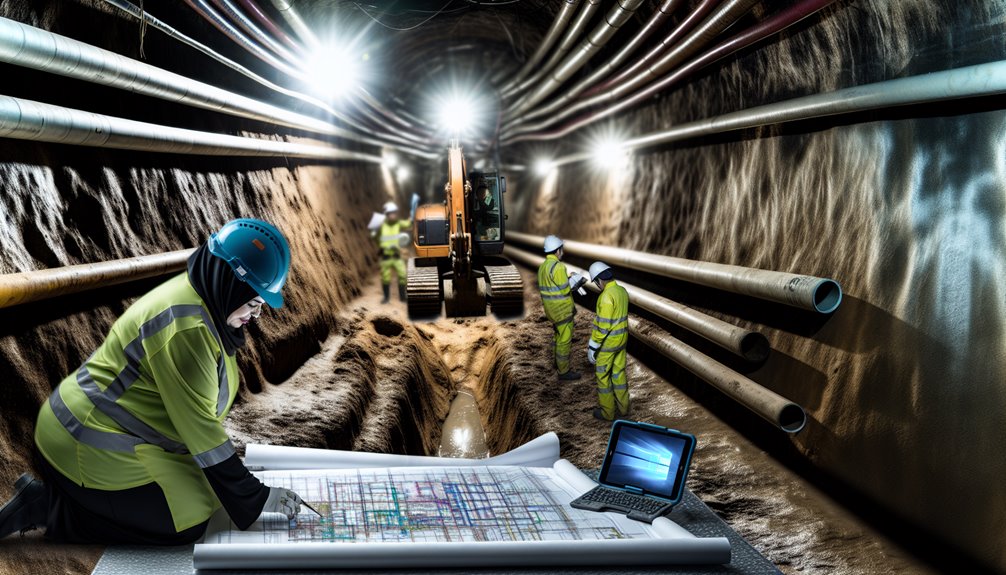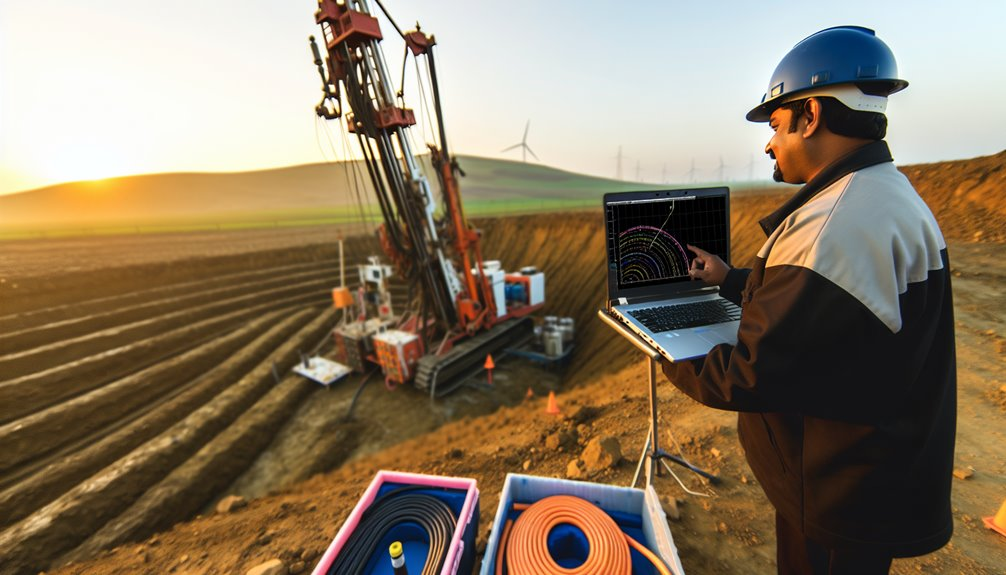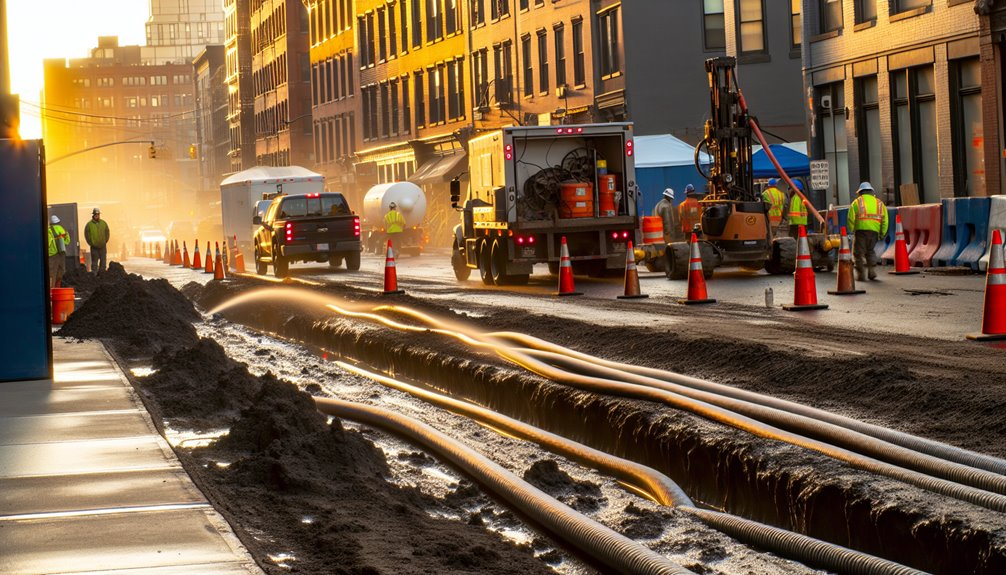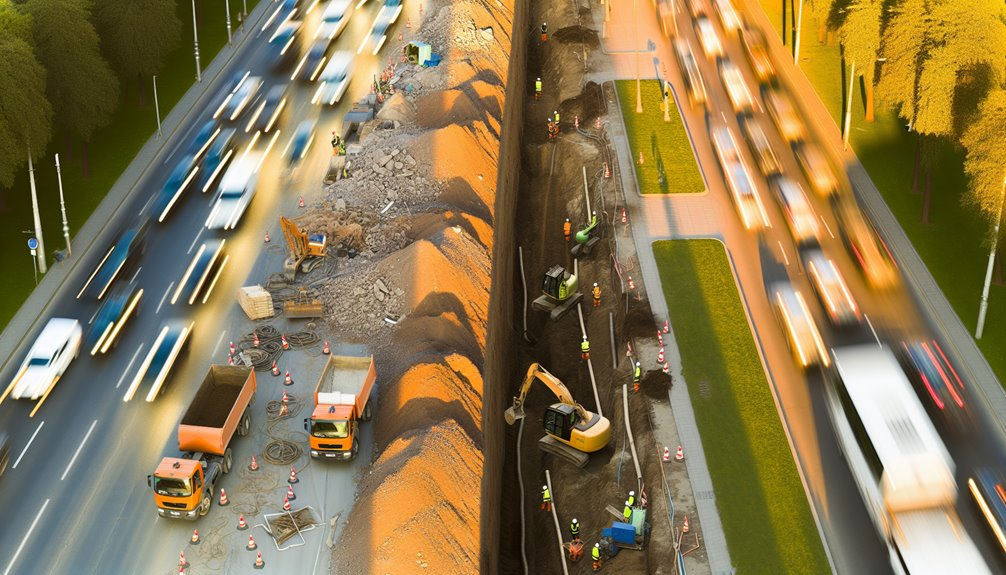As you commence on your next underground utility construction project, it's essential to grasp the complex web of regulatory compliance that governs these operations. You'll need to secure various permits and licenses, adhere strictly to environmental and safety protocols, and guarantee all installations meet local and state standards. Maneuvering through these regulations effectively not only keeps your team safe but also shields your project from costly penalties and delays. Let's explore how staying compliant can streamline your operations and safeguard your project's success.
Understanding the Basics of Underground Utility Construction Laws
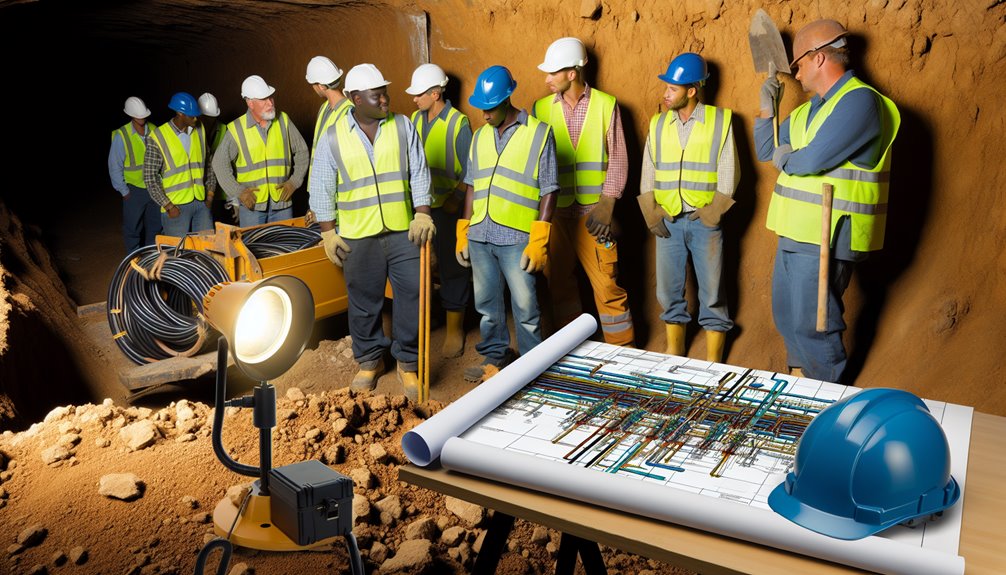
Before you begin any underground utility construction project, it's crucial to grasp the basic laws governing this type of work.
To start, accurately identifying the location of underground utilities is paramount. You'll need to consult utility mapping services and possibly use advanced excavation technology to determine the precise whereabouts and details of hidden installations.
If a utility company can't respond within 24 hours, deploy detection equipment to avoid delays.
Additionally, before engaging mechanized equipment, verify the utility's exact location, size, and depth using methods like vacuum excavation or hand-dug test holes.
These steps not only comply with legal requirements but also integrate innovative practices that enhance safety and efficiency in your project execution.
Moreover, to ensure the safety of your team, it is imperative to remove or support any surface encumbrances that pose a hazard before beginning excavation work. This practice minimizes the risk of accidents and injuries, aligning with safety regulations.
Key Permits and Licenses Required for Underground Projects
Obtaining the necessary permits and licenses is a critical step when planning an underground utility project. You must submit a permit application through the utility owner's account, which can also be accessed by consultants for ease.
This application process includes compliance verification with the Utility Accommodation Rules (UAR) as outlined in the Texas Administrative Code.
Your project must feature a Traffic Control Plan (TCP) compliant with the Texas Manual on Uniform Traffic Control Devices, guaranteeing minimal disruption to traffic and maximum safety for the public.
Additionally, you'll need to ascertain that the placement of utility installations doesn't conflict with existing facilities or impede future roadway projects, maintaining horizontal clearance as per TAC Rule 21.40.
Ensure that all construction activities adhere to environmental regulations to prevent adverse impacts on the surrounding ecosystem.
Environmental Protection Regulations Specific to Subterranean Construction
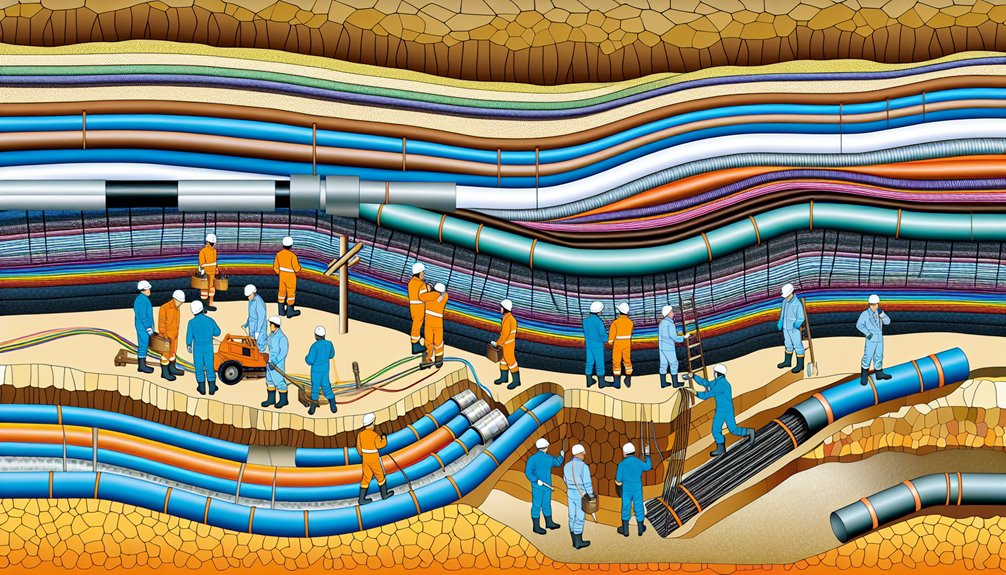
After securing the necessary permits and licenses for your underground utility project, focus must shift to adhering to rigorous environmental protection regulations.
You'll need to implement sustainable practices and prioritize contamination prevention. Start by conducting thorough pre-construction geological surveys to assess potential impacts on groundwater and soil.
Install measures like berms or grout curtains to prevent water from infiltrating hazardous areas. Make certain all contaminated water is securely contained and disposed of according to strict regulations.
Regularly inspect excavation sites for signs of soil contamination and manage spills effectively.
It's vital to coordinate with environmental authorities to align your actions with federal, state, and local laws, guaranteeing your project supports long-term environmental health and compliance.
Safety Protocols and OSHA Standards for Underground Work
As you navigate the complexities of underground utility construction, it's vital to understand the specific OSHA excavation requirements that govern your operations.
These standards are designed to guarantee that all work sites meet essential safety benchmarks, particularly in emergency response planning.
You'll need to integrate these protocols thoroughly to maintain compliance and protect your workforce effectively.
OSHA Excavation Requirements
To guarantee the safety of workers during underground utility construction, it's essential that all excavation activities comply with the Occupational Safety and Health Administration (OSHA) standards.
You must understand that any excavation deeper than four feet requires secure ingress and egress points every 25 feet. Significantly, your excavation techniques must account for soil stability, critical in choosing protective systems like shoring or shielding, mandated for depths over five feet.
A competent person, familiar with these standards, must inspect the site daily, evaluating changes in soil type and environmental conditions. This role isn't just procedural but pivotal, ensuring that your methods aren't only compliant but fundamentally secure, thereby minimizing risks in dynamic underground environments.
Emergency Response Planning
Effective emergency response planning is essential in underground utility construction, ensuring rapid, coordinated action in crisis situations. You must develop extensive plans that include liaising with emergency services and integrating utility mapping software. This technology provides real-time data, enhancing decision-making and response speeds during emergencies.
Regular emergency drills and contingency planning are vital, ensuring every team member knows their role and can respond effectively.
Implement safety protocols rigorously; conduct thorough planning and frequent safety audits. Use IoT devices to monitor environmental conditions and detect hazards such as fumes or unstable soil. Always verify the location of underground utilities with precision tools to prevent accidents.
Navigating Local and State Regulations for Utility Installations
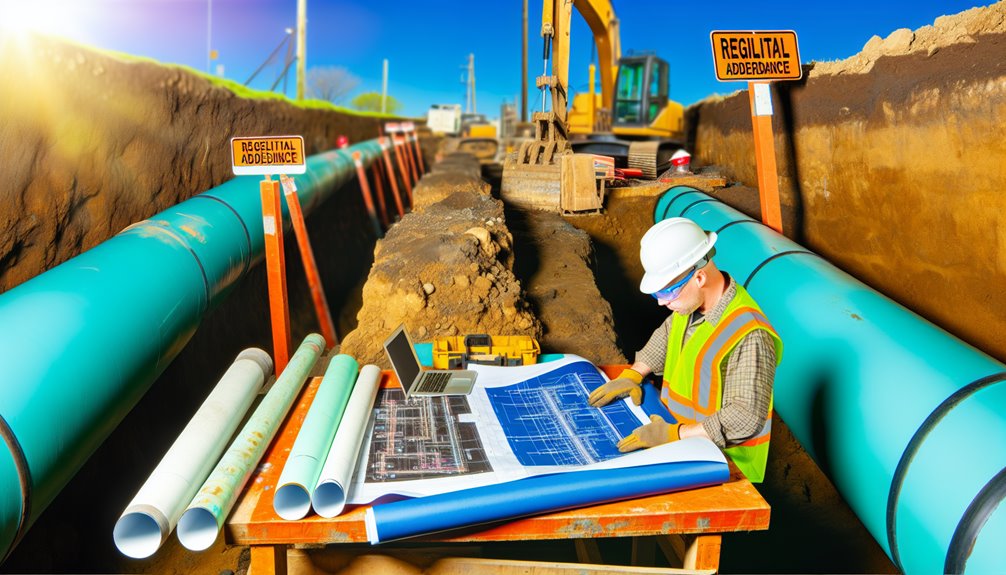
Maneuvering local and state regulations for utility installations requires understanding and complying with a complex array of guidelines.
You'll need to secure highway occupancy permits or utility agreements, particularly for projects that involve adjustments or relocations due to highway developments. Each state mandates that utility installations within right-of-way areas comply strictly with predefined locations and safety standards.
Furthermore, local zoning laws may not directly address your project's specifics, necessitating a detailed administrative review or bespoke interpretations to align your project with local frameworks.
This variability in local regulations underscores the significance of meticulous planning and consultation to guarantee compliance.
You're steering through a landscape where innovation meets regulation, and precision in following these guidelines is vital for project success.
Impact of Non-Compliance on Projects and Penalties Involved
While non-compliance might save time or resources in the short term, the repercussions for underground utility construction projects can be severe and multifaceted. Here are the critical aspects you should consider:
1. Project Delays and Costs: Non-compliance consequences often lead to extended timelines due to failed inspections and mandatory corrective actions.
These delays not only push your project beyond its intended scope but also substantially inflate costs due to rework and legal battles.
2. Legal and Financial Repercussions: You're looking at hefty fines, potential lawsuits, and even the loss of licenses or certifications.
This can jeopardize your company's operational status and financial health.
3. Safety and Reputation Risks: Accidental utility damages can pose serious safety risks and environmental hazards, damaging your reputation and straining client relationships.
Prioritizing compliance mitigates these risks and fosters trust.
Strategies for Effective Communication With Regulatory Bodies
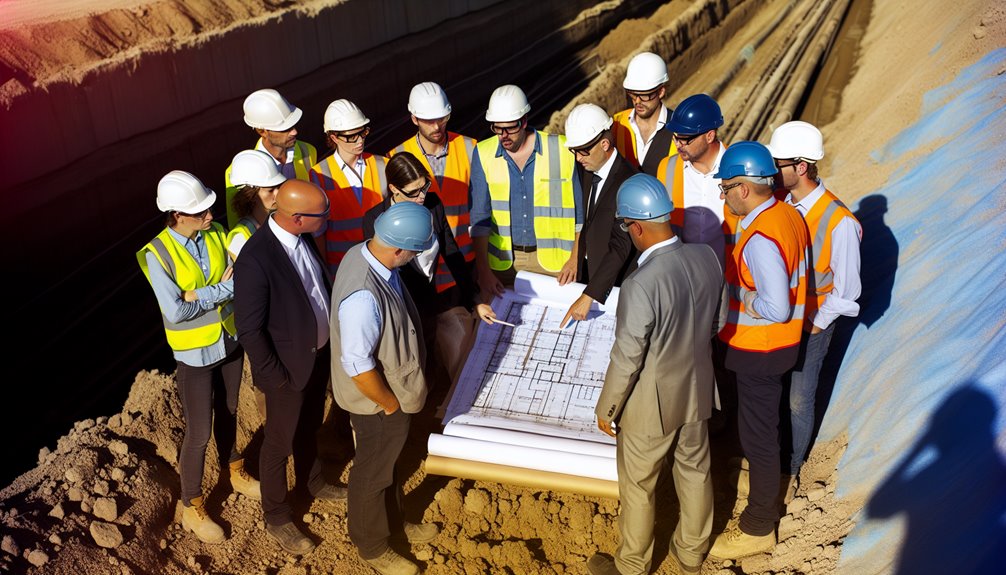
How can you guarantee seamless communication with regulatory bodies during your underground utility construction projects?
First, establish a transparent chain of command and clear communication protocols. Define specific roles and responsibilities, making certain everyone knows their point of contact and decision-making authority.
Implement project management software to centralize information and facilitate real-time updates, essential for maintaining stakeholder engagement.
Educate your team on relevant regulations to make sure all communications are compliant.
Utilize cloud-based platforms and specialized tools tailored for the construction industry to streamline communication processes.
Regularly scheduled meetings and documented communications help demonstrate compliance and foster proactive discussions.
Best Practices for Ongoing Compliance and Project Auditing
To maintain compliance with regulatory requirements throughout your underground utility construction project, it's essential to implement a robust auditing process.
Here are three best practices:
- Regular Compliance Audits: Conduct both internal and external compliance audits frequently. This guarantees continuous adherence and helps in early identification of areas at risk of non-compliance.
- Update Policies Regularly: Stay ahead by integrating the latest regulatory updates into your operational policies. This proactive approach prevents compliance gaps as regulations evolve.
- Thorough Documentation: Maintain meticulous records of all compliance efforts and audits. Detailed documentation supports transparency and is invaluable for both historical reference and future training.
Adhering to these practices will safeguard your projects against compliance pitfalls and regulatory scrutiny.
Conclusion
As you navigate the complexities of underground utility construction, remember that maintaining compliance isn't just about following rules—it's essential for safety, efficiency, and environmental stewardship. Guarantee you've obtained all necessary permits, adhere strictly to UAR, and keep up with OSHA standards. Regularly communicate with regulatory bodies and conduct thorough audits to avoid penalties and project delays. By embedding these practices, you'll minimize risks and contribute to a successful project outcome.
If you're looking for more insights or need assistance with your underground utility projects, I invite you to visit Boring Bros at boringbro.com or give us a call at (954) 639-6167. We're here to help you navigate these challenges with ease and ensure your projects run smoothly. Don't hesitate to reach out; we'd love to chat!

